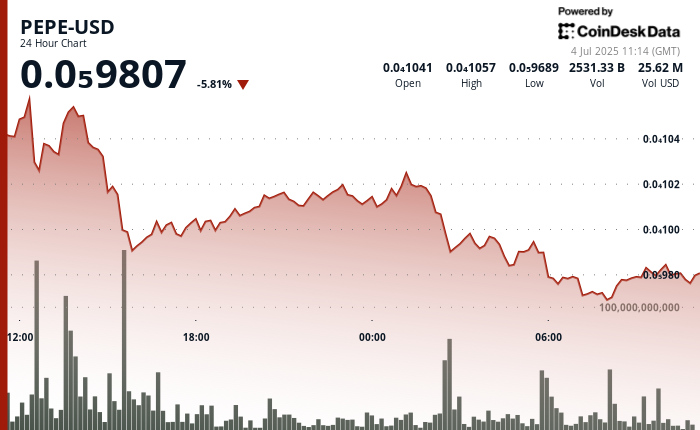The Recent Decline of PEPE: Analyzing Market Trends and Investor Sentiment
The frog-themed memecoin PEPE (PEP) experienced a notable decline of nearly 6% in the past 24 hours due to geopolitical events, particularly Trump’s reciprocal tariffs deadline, which has sent shockwaves through the cryptocurrency market. This price drop, alongside a trading range swing of 16.5%, highlights the inherent volatility of PEPE amidst dwindling trading volumes susceptible to macroeconomic cues. As global financial landscapes shift, such rapid sentiment changes become increasingly pronounced.
Despite the downturn, large wallet holders, commonly referred to as "whales," have shown strength in their investment strategies. According to blockchain analytics from Nansen, significant addresses have increased their PEPE holdings by over 5% within the last month. These wallets now hold tokens valued at approximately $3 billion, making up more than 70% of PEPE’s total supply. This substantial acquisition by large players illustrates a divergence between retail and institutional sentiment in volatile markets.
In terms of exchange metrics, PEPE’s availability has decreased significantly, with total supply on exchanges shrinking to a two-year low of roughly 247.2 trillion tokens—a nearly 3% decrease since the beginning of July. This drop in supply could be a contributing factor to the price dynamics as lower liquidity often leads to increased volatility, especially for assets like memecoins that are sensitive to speculative trading.
Technical analysis derived from CoinDesk reveals that PEPE has struggled to maintain gains after reaching a resistance level around $0.0000106. Persistent selling pressure has pushed the price down, although it found modest support near $0.00000965, preventing further decline for now. The ongoing chart patterns suggest a downward trend, characterized by a descending channel where sellers have dominated price recoveries. Still, brief upward price spikes hint that some traders may expect future opportunities for rebounds if market sentiment were to improve.
Interestingly, the shifts in trading volume patterns during upward price movements signify that many traders may be offloading their positions rather than initiating new long strategies. This behavior could hint at a market correction phase, where profit-taking becomes prevalent amid uncertainty. However, the sporadic volume bursts indicate that not all traders are exiting; some are positioned for potential upward trends, signaling a contested market environment.
In summary, PEPE’s recent price action encapsulates a blend of factors—geopolitical concerns, whale accumulation, and overall market sentiment. While the memecoin has encountered notable resistance and volatility, the activities of major holders and evolving trading dynamics could play critical roles in shaping its future trajectory. As investors navigate this unpredictable landscape, understanding the nuanced influences of macroeconomic indicators and trading patterns will be essential for making informed decisions in the ever-evolving world of cryptocurrencies.


